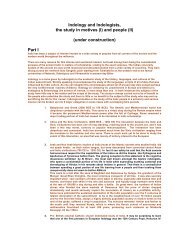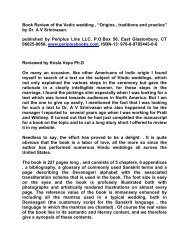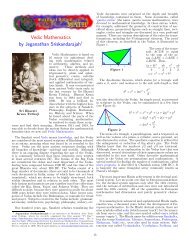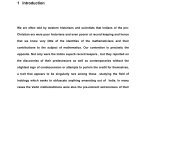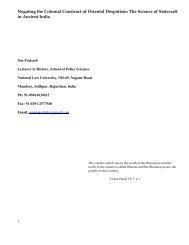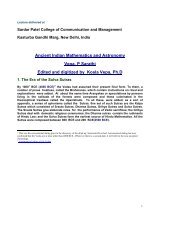The Dhaarmik Traditions - Indic Studies Foundation
The Dhaarmik Traditions - Indic Studies Foundation
The Dhaarmik Traditions - Indic Studies Foundation
You also want an ePaper? Increase the reach of your titles
YUMPU automatically turns print PDFs into web optimized ePapers that Google loves.
four varnas. <strong>The</strong>se are the regular duties including the rituals and services to the<br />
family, community, ancestors and God that every one is expected to perform. .<br />
7. Who composed the Hindu scriptures and when were they composed<br />
<strong>The</strong>re were many composers of the Veda. It was not unusual for the brother of the<br />
King to become the Rishi Chronicler of that reign and compose the relevant Mandala<br />
of the Veda. We will compile the names of these composers and make these available<br />
in Tabular form.<br />
It is difficult to ascribe an individual to each and every one of the texts, but if there<br />
is any one individual that had a major part in writing the later texts it must have been<br />
VedaVyaasa or Krishna Dvaipayana. Veda Vyasa (or Baadaarayana) which was also<br />
one of his names composed the Mahabharata and the Brahma Sutras. Veda Vyasa<br />
was born of the union of a fisherwoman and the sage Parasara. <strong>The</strong>re is as yet no<br />
consensus on an accepted date for the composition of the scriptures. If one accepts<br />
the end of Kaliyuga as a marker for the Great Bharata War, then the logical date for<br />
the chronicling of the Mahabharata war is around 3139 BCE. <strong>The</strong> Vedas predate the<br />
Epics by about 2 millennia.<br />
8. What was the language in which the vast Vedic scriptures (Sruti<br />
and Smriti ) were composed <br />
<strong>The</strong> language in which they were written was Sanskrit. More specifically the Vedas<br />
and many of the earlier texts were written in Vedic Sanskrit before it was codified<br />
by Panini. At that time the scripts were not fully developed and the transmission of<br />
knowledge was primarily oral. <strong>The</strong> transition to a likhita Parampara (scriptural<br />
tradition) from a srauta Parampara was of course not instantaneous but took<br />
several centuries. It took several more centuries for a standardized script to evolve<br />
from the proto scripts (Brahmi and Kharosthi)<br />
39



